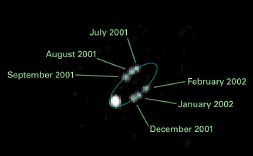

|
Документ взят из кэша поисковой машины. Адрес
оригинального документа
: http://www.stsci.edu/~inr/thisweek1/thisweek149.html
Дата изменения: Fri Jun 8 23:36:03 2007 Дата индексирования: Tue Oct 2 14:05:20 2012 Кодировка: Поисковые слова: coma |


| Program Number | Principal Investigator | Program Title | Links |
| 10145 | Alfred Vidal-Madjar, CNRS, Institut d'Astrophysique de Paris | Physical parameters of the upper atmosphere of the extrasolar planet HD209458b | Abstract |
| 10474 | Gordon Drukier, Yale University | Shooting Stars: Looking for Direct Evidence of Massive Central Black Holes in Globular Clusters | Abstract |
| 10488 | Mariangela Bernardi, University of Pennsylvania | The Most Massive Galaxies in the Universe: Color-Gradients and Texture | Abstract |
| 10493 | Avishay Gal-Yam, California Institute of Technology | A Survey for Supernovae in Massive High-Redshift Clusters | Abstract |
| 10494 | Leon Koopmans, Kapteyn Institute | Imaging the mass structure of distant lens galaxies | Abstract |
| 10496 | Saul Perlmutter, Lawrence Berkeley National Laboratory | Decelerating and Dustfree: Efficient Dark Energy Studies with Supernovae and Clusters | Abstract |
| 10504 | Richard Ellis, California Institute of Technology | Characterizing the Sources Responsible for Cosmic Reionization | Abstract |
| 10508 | William Grundy, Lowell Observatory | Orbits, Masses, and Densities of Three Transneptunian Binaries | Abstract |
| 10514 | Keith Noll, Space Telescope Science Institute | Kuiper Belt Binaries: Probes of Early Solar System Evolution | Abstract |
| 10536 | Raghvendra Sahai, Jet Propulsion Laboratory | What Are Stalled Preplanetary Nebulae? An ACS SNAPshot Survey | Abstract |
| 10539 | Karl Stapelfeldt, Jet Propulsion Laboratory | Coronagraphic Imaging of Bright New Spitzer Debris Disks | Abstract |
| 10547 | Edward Fitzpatrick, Villanova University | A SNAP Program to Obtain Complete Wavelength Coverage of Interstellar Extinction | Abstract |
| 10556 | David Turnshek, University of Pittsburgh | Neutral Gas at Redshift z=0.5 | Abstract |
| 10559 | Herve Bouy, Instituto de Astrofisica de Canarias | Astrometric monitoring of binary L and T dwarfs | Abstract |
| 10573 | Mario Mateo, University of Michigan | Globular Clusters in the Direction of the Inner Galaxy | Abstract |
| 10588 | Michael Brotherton, University of Wyoming | The Host Galaxies of Post-Starburst Quasars | Abstract |
| 10592 | Aaron Evans, State University of New York at Stony Brook | An ACS Survey of a Complete Sample of Luminous Infrared Galaxies in the Local Universe | Abstract |
| 10612 | Douglas Gies, Georgia State University Research Foundation | Binary Stars in Cyg OB2: Relics of Massive Star Formation in a Super-Star Cluster | Abstract |
| 10613 | Todd Henry, Georgia State University Research Foundation | Calibrating the Mass-Luminosity Relation at the End of the Main Sequence | Abstract |
| 10626 | Yeong-Shang Loh, University of Colorado at Boulder | A Snapshot Survey of Brightest Cluster Galaxies and Strong Lensing to z = 0.9 | Abstract |
| 10635 | Bodo Ziegler, Georg-August-Universitat | Galaxy Transformation as probed by Morphology and Velocity Fields of Distant Cluster Galaxies | Abstract |
| 10775 | Ata Sarajedini, University of Florida | An ACS Survey of Galactic Globular Clusters | Abstract |
| 10842 | Kem Cook, Lawrence Livermore National Laboratory | A Cepheid Distance to the Coma Cluster | Abstract |
| 10989 | George Benedict, University of Texas at Austin | Astrometric Masses of Extrasolar Planets and Brown Dwarfs | Abstract |
GO 10145: Physical parameters of the upper atmosphere of the extrasolar planet HD209458b
GO 10514: Kuiper Belt Binaries: Probes of Early Solar System Evolution
 Composite HST image of the Kuiper Belt binary, WW31
Composite HST image of the Kuiper Belt binary, WW31
|
The Kuiper Belt consists of icy planetoids that orbit the Sun within a broad band stretching from Neptune's orbit (~30 AU) to distance sof ~50 AU from the Sun (see David Jewitt's Kuiper Belt page for details). Over 500 KBOs are currently known out of a population of perhaps 70,000 objects with diameters exceeding 100 km. Approximately 2% of the known KBOs are binary (including Pluto, one of the largest known KBOs, regardless of whether one considers it a planet or not). This is a surprisingly high fraction, given the difficulties involved in forming such systems and the relative ease with which they can be disrupted. It remains unclear whether these systems formed from single KBOs (through collisions or 3-body interactions) as the Kuiper Belt and the Solar System have evolved, or whether they represent the final tail of an initial (much larger) population of primordial binaries. This proposal aims to use ACS/HRC images of known KBOs toidentify new binary systems. |
GO 10573 Globular Clusters in the Direction of the Inner Galaxy
GO 10842 A Cepheid Distance to the Coma Cluster